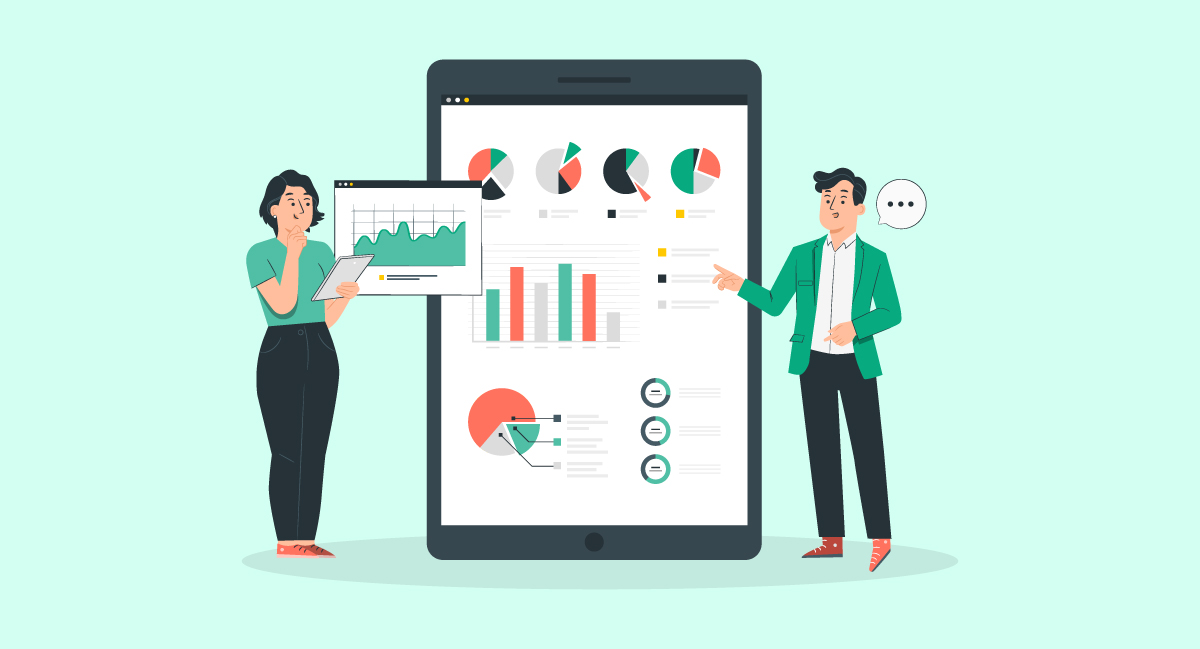Business intelligence, or BI, is a powerful tool that helps businesses track data, analyze the information, and present it in a meaningful format. Businesses that use BI to make decisions are 5 times more likely to achieve quicker decisions and consensus than those that do not, which reveals the significance of business intelligence in decision-making.
In this blog, we have outlined real-time business intelligence applications that can analyze data in different industries. We have also curated 10 examples of business intelligence that can serve as references and starting points for other businesses.
What Are the Enterprise Applications of Business Intelligence?
Business Intelligence refers to technologies that help organizations gather business data, make an analysis, and present the findings in a form that the relevant stakeholders can easily perceive. The insights from data and visuals help organizations make informed decisions and effective strategies.
Pro-tip
Businesses that use business intelligence get to make informed, quick decisions. Given the competitiveness of today’s business landscape, businesses must leverage business intelligence applications to stay ahead of their industrial counterparts.
Given the intense competition in today’s marketplaces, BI applications remain the most sought-after. Organizations are on a spree to leverage the benefits of BI and stay relevant to the industry and market demands. From finance to retail and gambling, the use of Business Intelligence applications is spread across a broad spectrum of industrial domains, and some of them are listed in the following section.
1. BI for the Finance Industry
The BFSI (Banking, Financial Services, and Insurance) domain endures several challenges, from intense competition to constantly evolving customer demands. Business intelligence techniques can help firms spot emerging trends and patterns, monitor the effectiveness of their products and services, mitigate the risk of unknowns, and build new investment strategies.
Banks, and firms in the financial services sector can automate the end-end loan application and processing process. Using relevant BI apps, customer data can be collected from different data sources, stored, and made accessible to the relevant stakeholders. Doing so prevents silos and enhances transparency in the process.
Similarly, financial firms can leverage Business Intelligence applications to mitigate the risks involved in many of their products and services. Based on customer transactions’ history, earning capacity, and financial holdings, firms can estimate the risk of granting loans or other debt instruments like credit cards.
Business Intelligence applications can monitor the performance and revenue data of different products and services. Based on the data collected, the firms can identify those offerings that are profitable and those that are not. Asset managers can perform sentiment analysis using customer data and build investment strategies.
2. BI for Manufacturing
Using the right BI apps helps manufacturing businesses enhance operational efficiency. Business Intelligence apps help stakeholders gain a complete picture of their supply chain. The analytics derived from such tools help businesses make reliable forecasts and manage inventory. Doing so reduces the lead time and enhances the capability of the firm to meet just-in-time demands.

With data on the workstation capacity and human resource availability, BI tools help manufacturing firms schedule their production process to effectively utilize the available resources. As stakeholders can gain a complete view of the supply chain operations, firms can track costs and work out ways to minimize them.
Also, BI tools help monitor the downtime of employees and the machinery and equipment in a manufacturing firm. The data helps them undertake predictive maintenance and ensure continuous, uninterrupted operation. Based on the data available, firms can monitor the manufacturing cycle of a product and work out ways to reduce the length of the cycle.
3. BI for Online Gambling
Online gambling has been experiencing remarkable growth recently. Casino operators use BI tools to gain insights into which games are doing well and what they can do to reach more players. Online casinos operate worldwide and can use data and analytics to understand where your games are popular. Also, understanding players’ interests helps online gambling companies design the best games.
Countries are introducing stringent rules to regulate the online gambling industry. In such cases, the casinos must acquire licenses from legal authorities, which must be renewed periodically. BI tools help prepare regulatory reports at a quicker pace and simplify the compliance needs of the business.
Also, as BI applications track real-time data, the IT department can monitor the data, identify irregularities, and sort them out so the customers can enjoy an uninterrupted gaming experience. Business intelligence techniques helps design bonuses, discounts, and promotions for the players to attract more players.
4. BI for Hospitality
Hospitality businesses deal with a wide range of customers, and retaining them depends on the degree of personalization you offer in the services. Businesses in the hospitality industry depend on business intelligence to make reliable forecasts about occupancy rates. Such forecasts are made while considering several attributes like seasonal changes, trends, and patterns, and so they help businesses maximize their revenue.
Reliable forecasts help hospitality businesses adopt a dynamic pricing model, which has several benefits in terms of revenue optimization. Hospitality businesses also use BI tools to gather booking data through websites, POS systems, CRM software systems, etc.. Using this data, businesses can offer a higher degree of personalization. Similarly, businesses in the hotel industry rely on BI apps to determine which items on their menu are demanded more.
Hotel businesses can use insights from business intelligence techniques and tools to understand when the demand is high. Such forecasts help hotels manage customer demand more effectively. By doing so, hotels can offer discounts for customers who visit the hotel during off-peak hours.
5. BI for Retail
Traditionally, retail businesses relied on spreadsheets and static reports to make decisions. But with BI gaining prominence, businesses can generate dynamic, real time reports and make informed decisions regarding customization, dynamic pricing, floor plan, inventory management, competitor analysis, customer trends, etc.,
Retail firms can use Business Intelligence apps to collect and access data about demographics, sales, purchase history, etc. By processing this information, they can make reliable forecasts about customer demand and manage inventory accordingly. Also, businesses can leverage customer behavior information to personalize their offerings. They can also use the information to build a floor plan so customers can find what they need without hassles.
BI can help retail businesses track their marketing campaign’s performance and make necessary changes. They can leverage the features of BI applications to launch and manage stores in multiple locations.
What BI Tools Assist in Applications?
As the previous section shows, BI tools have applications in wide-ranging industries. Each industry listed above can be used to monitor and track different business activities like sales, performance management, reporting, etc. We have covered each of them in detail in the coming section.
1. Sales Intelligence
Sales remains one of the key Business Intelligence applications. Irrespective of the size and scale of the business, the key objective of the sales department in all organizations is to push leads and prospects toward the end of the funnel at a minimum cost.

Businesses can use BI tools to collect data on customer demographics, conversion rate, lifetime value, and other relevant sales metrics. They can organize the data into structured graphs, charts, etc. Businesses can use visual reports to derive trends and patterns in customer behavior and leverage them to make real-time decisions. Such data-driven decisions help businesses generate quality leads, boosting their profits, revenue, conversion rates, etc.
Today’s marketplaces are constantly changing and rapidly evolving, and so is customer preference. BI tools help businesses enhance the effectiveness of their sales process. By analyzing trends and data about their leads and prospects, businesses can improve their lead-generation process’s efficiency.
For businesses operating in other countries, BI tools can help collect customer data and determine what works for them in each territory. Businesses can use the data to track every sales pipeline activity and identify improvement areas.
Businesses can use BI tools to track historical data on sales trends, purchasing behavior, etc., and use the same to make reliable sales forecast. Doing so helps businesses identify seasonal trends and plan their inventory, which helps them meet the rise in demand during peak season or manage their funds during the off-season when there is no demand.
2. Visualization
Firms generate enormous amounts of data at each point of their business operations which in their original form are unstructured. All your data must be organized to derive insights, and the business’s success depend on how best it puts the data to use in real-time. Firms use business intelligence applications to visualize their data in the form of infographics, charts, graphs, etc., which can help stakeholders make business decisions in a quick span of time.
BI tools helps businesses create customized reports based on the KPIs and metrics most important to them. The best thing about visualization is that it presents data in an appealing, easy-to-understand format. This way, even those employees and stakeholders who do not have tech expertise can perceive the data and make informed decisions. Doing so reduces their dependence on data science experts.
Also, studies show that our brains have the power to process images 60,000 times faster than text. So, converting raw data into visuals enhances processing speed and enables quicker decisions. Traditionally, businesses relied on static reports, and new reports must be generated if there is a shock to a variable. Modern dashboards and visualization tools are interactive, dynamic, and constructed using real-time data.
3. Reporting
As mentioned above, the main purpose of business intelligence applications is to convert original, unstructured data into an organized format. Doing so helps businesses monitor their performance and make changes wherever needed. Businesses rely on several reports, including sales, inventory, customer research, performance, staffing, etc., to devise informed strategies.
Reporting and data analysis are commonly used interchangeably, but their objective and purpose differ. Reporting helps translate data into plain information, while analysis helps turn data into insights. In other words, reporting shows what is happening in the business, while the insights from data analysis show why it is happening. Reporting helps summarize the data, and the insights can be used to enhance the effectiveness of business practices.
4. Performance Management
Business intelligence applications can be used to monitor and track the performance of businesses in real time. Project management teams have targets and deadlines, and businesses can track real-time information to identify gaps and make important changes.
Managers and leaders can use the dashboards and visualizations from BI tools to delegate tasks, set KPIs, and monitor their performance. Such tools can notify employees of upcoming targets and deadlines so they stay in alignment with business objectives. The data can be used to identify the gaps in the process and make changes to enhance the productivity of an organization.
10 Business Intelligence Applications Examples
Business intelligence applications help translate raw, unstructured data into organized information. As the business landscape has become more competitive, businesses are working to stay ahead. So, there is naturally a rise in demand for BI applications, and as a result, several firms have ventured into the space.
To help you understand how you can leverage the BI tools to propel your business goals, we have listed 10 business intelligence applications. If you are exploring examples of business intelligence, this section has all the information you need.
1. Google
Google has been a pioneer in the BI space, for it has a team dedicated to people analytics within its HR department, which is a perfect example of business intelligence. The team focuses on enhancing the processes and productivity based on daily insights. Their people analytics team extensively researches HR, from leadership to productivity. It doesn’t stop here, but it works with the internal department to translate the insights derived from research into action.
Google has leveraged people metrics and data to build a happy, productive workplace. It started with a research study called Project Oxygen in 2008, and the objective was to understand what makes a manager great at Google. The research used data from appraisals, interviews, employee feedback, surveys, etc. The study showed that managers profoundly influenced employee productivity and outcomes.
From the study, Google identified ten behaviors for best managers. The study also revealed that Google employees wanted managers who could promote cross-collaboration and make strong decisions. The study showed that employees wanted managers who were results-oriented and not micromanaging.
2. LendingClub
LendingClub has become the largest online credit marketplace for financing personal, business, medical, and educational purposes. The service provider hired Heap, which helps businesses gain access to customers’ journeys and leverage the data to enhance customer conversion, satisfaction, and retention.
The company wanted to run A/B testing to identify the product preferences of a set of customers. With the BI abilities and tools from Heap, LendingClub could run 12 A/B tests a week, significantly higher than the 4 tests it performed a year. The company could test several product combinations, and based on the insights derived from such tests, it tweaked its offerings. Doing so helped the business reach more customers and boost its revenue.
3. Grow
Grow is a business intelligence firm, and it partnered with Heap to figure out what businesses expected during the free trial of its visualization tools.
The study revealed that customers who attempt to create a visualization within the first five minutes of them signing up for the Grow tool are more likely to become their regular, paying customers. This finding was a new revelation to Grow firm which had thought that customers prioritized quality and accuracy more than speed of setup.
Grow initially had a long setup process that took more than 90 minutes, and the users had to integrate their customer, marketing, sales, etc., data into the Grow platform to be able to use the tool. Based on the insight from the Heap business intelligence application, they worked on streamlining the setup process and reducing the time it takes.
4. Stitch Fix
Stitch Fix offers a virtual stylist to its customers, who are expected to complete a questionnaire with 90 data points, including size, height, style, etc. Based on the responses, the company styles the clothes, shoes, and other accessories and ships them to the customers. They can choose and buy what they like and return what they are uncomfortable with.
Initially, the stylist has access to limited data. But with repeated orders and continuous feedback, the business intelligence tools help analyze the data and make more meaningful recommendations to the customer. It uses eigenvector decomposition, a concept from quantum mechanics, to decode the overlapping notes and layers in a customer’s style. Doing this requires complex skills and abilities, which would be impossible without reliable business intelligence tools.
5. Target
Target is a popular retail chain housing apparel, accessories, beauty, food and beverages, toys, electronics, and home accessories. Because the store sells everything from home decor to milk and food, it had a hard time convincing customers that the only store they may have to visit to meet their basic needs is Target. It used the principles of habit formation to target customers and dish out personalized marketing offers and managers.
As a part of its marketing strategy, the Target store followed a pregnancy-prediction model. It would assess every female customer based on data points like shopping history and make a pregnancy prediction score. Based on the score, it would send coupons and personalized offers about diapers and cribs.
Back in 2012, the pregnancy-prediction model had estimated high scores for a young girl who was doing high school. When the store started receiving complaints, it apologized and turned out to leverage business intelligence abilities to make more accurate, personalized recommendations without surveilling the subtle nuances of the customers.
6. Payless Shoes
Payless Shoes evolved into one of the USA’s largest footwear retailers. The company always worked on enhancing customer experience, and when it started going online, it initially assumed that customers expected a one-click buying experience. When businesses started selling online, all of them were driven by the notion that customers enjoyed shopping from websites with fewer clicks than otherwise.
But after partnering with Heap, the leading Business Intelligence application platform, data from customers of Payless Shoes revealed they preferred a two-click process.
7. Twitter
When Twitter was launched in 2006, it restricted tweets to 140 characters. In 2017, the platform started allowing 280 characters. But analysts and users thought it might backfire because allowing 280 characters may make the posts wordy. They thought users might discard the platform as there may be a drop in meaningful anecdotes and short jokes.
But against the notion, users enjoyed tweeting. As they could add longer tweets than before, they did not have to spend their time adjusting and rephrasing the content to 140 characters anymore. Twitter had brought this change based on the insights from their Business Intelligence tools, whereas users did not have access to such tools. Such tools helped businesses make meaningful decisions.
8. Facebook
Facebook relies on business intelligence to improve the features and functionalities of the platform. Academia has also started showing interest in analyzing the platform’s impact on people’s lives.
One such study conducted by Stanford University suggested that Facebook usage has a detrimental effect on the mental health of its users. The primary cause was that people tend to compare their lives with that of others and develop a feeling of scarcity. They fail to understand that people on Facebook decide how they wish to be perceived by the community and carefully curate their best version.
People tend to compare the number of likes they have received and someone else has received and form opinions. Based on this observation, the company allowed users to keep their like counts private so only the profile owner could see how many likes their posts received.
9. TikTok
TikTok remains a popular communication and social media platform. The app offers users recommendations based on their preference data to keep them hooked on to the app. You only need to download the app from AppStore or Google Play Store and start watching videos.
When you react to the videos with a hard press or heart symbol, the app’s algorithm reads user preferences and makes recommendations. As it recommends videos the users are interested in, they tend to spend more time using the app. Doing so is very important in this era where social media apps strive to increase users’ time on their platforms.
10. Uber
Uber, the robust ride-hailing app, launched its food delivery under the aegis of UberEATS. The company leveraged the power of business intelligence applications to generate data and actionable insights that help propel business objectives.
UberEATS launched Restaurant Manager, a business intelligence app to help restaurant partners gain access to important metrics and KPIs like net order value, revenue, items sold on the app, customer feedback, etc. Based on the data, restaurants can gain insights into what items are most demanded by customers. The partners can also make reliable forecasts, ensure timely delivery, and enhance customer satisfaction.
Selection Process for the Right BI Software
In the above section, we curated some notable examples of business intelligence. As you know the applications and examples of business intelligence, let us move ahead to understand how you should choose the right Business Intelligence software for your business.
1. Gather Requirements
As organizations function with different purposes and goals, their intelligence and data requirements differ. The first step in selecting a business intelligence application is identifying and listing your business requirements.
As business intelligence remains a broad field, implementing its entirety may not be useful. You should select only the modules that will add value to your purpose. Doing so helps reduce the business cost and simplifies the process. Perhaps, you can always scale as you grow.
2. Compare Applications
There are several BI tools in the market, and you must research them before you choose one. You must also watch out for their specialization, as different types of BI tools go well with different niches. The easiest way to choose one that aligns with your business requirement is to compare their features, functionalities, pros, and cons.
You must rate each business intelligence tool and choose the one that matches your requirements.
3. Shortlist and Trials
Shortlist the ones you think are appropriate for your business needs as you compare. Select four or five vendors that meet your major requirements. Almost all the vendors offer free trials or demos. You should request a trial or demo and experience the platform’s features. When you do so, make sure that you choose ones that a majority of the stakeholders in your organization can use.
While checking for features and functionalities, make sure that you also check for their integration abilities, customer support, pricing, etc.
Closing Thoughts
Business intelligence applications are rapidly evolving as more and more businesses demand interactive dashboards and dynamic reports based on real-time data. Leveraging the enterprise applications of business intelligence, firms can gain access to customer data, capture market trends, generate quality leads, monitor team performance, etc., using business intelligence software solutions.
The global business intelligence market is expected to reach a whopping $54.27 billion by 2030 with a CAGR of 9.1%. So, suppose you have not deployed business intelligence software solutions. In that case, it is the most appropriate time to invest in one, as otherwise, there are chances that you might be losing business.
Frequently Asked Questions
The following are some of the crucial features of a business intelligence application.
- Data visualization
- Interactive dashboards
- Reporting
- Integration abilities
- Location intelligence
- Security and data protection
- Self-service analytics
- Predictive business analytics
- Mobile BI
- Metadata layer

Supriya is a highly skilled content writer with over 8 years of experience in the SaaS domain. She believes in curating engaging, informative, and SEO-friendly content to simplify highly technical concepts. With an expansive portfolio of long-format blogs, newsletters, whitepapers, and case studies, Supriya is dedicated to staying in touch with emerging SaaS trends to produce relevant and reliable content.
Need Any Technology Assistance? Call Pursho @ 0731-6725516





